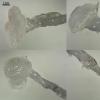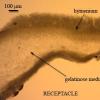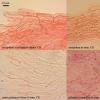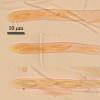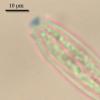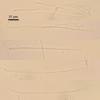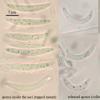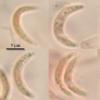
24-12-2025 17:08
Hulda Caroline HolteHello, I have found this propoloid ascomycete on

21-12-2025 09:32
Hello.A tiny ascomycete found embedded in wood in

21-12-2025 21:32
Pol DebaenstHello, Garden, Burgweg 19, Veurne, BelgiumOn 10/1

22-12-2025 23:38
Patrice TANCHAUDBonsoir, récolte sur un mur en pierre, apothéci

22-12-2025 00:47
Patrice TANCHAUDBonsoir, récolte à proximité du milieu dunaire
Ombrophila cf. lacustris
Nina Filippova,
22-02-2013 13:40
Growing on leaf sheaths of Carex rostrata in bog, 18.09.2012, N61,058846° E69,467926°.
Apothecia turbunate, with long stipe (16 mm), graduating to receptacle (4 mm diam), outer surface of stem covered by slime, disc and outer surface have the same whitish color, translucent.
Stem composed of outer gelatinose layer, excipulum (porrecta) and medulla (gelatinosa), receptacle lacking outer gelatinose layer and have excipulum from textura globosa-prismatica, medulla the same; cells of prismatica at stem 46 x 8,7; at receptacle 40 x 15; hyphae in medulla 2,5 broad; outer gelatinose layer hyphae 2 mk broad, ended with enlarged clavate cells up to 8 mk broad; asci cylindrical, with not clear clamp, pore euamyloid, 64,5-74,7 x 5-6,5; paraphyses cylindrical with some enlargement to the tip (2 mk broad at tip), without VBs, segmented, rarely branched; spores fusoid when in asci, upon release becoming strongly curved, many guttulate, 19,5 (18-21) x 2,5 (2,2-2,7) (10 straight spores measured).
Hans-Otto Baral,
22-02-2013 14:26

Re : Ombrophila cf. lacustris
yes, the paraphyses are never 5 µm wide. But this is a very difficult species. The type of O. lacustris fits O. pileata Karsten as redescribed by Dennis 1956 (as Helotium pileatum). But I found some spores to be strongly C-shaped (see my drawing 7080). On the other hand, I found in Karsten's type of pileata only short, mainly C-shaped spores! Confusion perfect.
Zotto
Zotto
Nina Filippova,
22-02-2013 15:23
Re : Ombrophila cf. lacustris
Thanks, Zotto.
I've noticed that spores collected from stipe (washed away here) all were strongly curved, in contrast with tapped mount where spores were forced to release, and there they were curved and straight both. There is one more picture of such spores from stipe, only strongly curved. So, probably they become curved some time after release? I may study this repetedly, i have two more frbs.
Hans-Otto Baral,
22-02-2013 15:34

Re : Ombrophila cf. lacustris
in some species this curvature depends on the treatment (usually curvature is less when killed). In any case I know that living spores which are freshly ejected from asci may be strongly curved (HB 5656, 1012), the curvature to some degree already present inside the living asci.
Now I see: HB 6200 (Karsten 2061, in H) shows the type of pileata with long straight spores which corresponds to his diagnosis. HB 4498 (same coll. from M) does not fit the protologue, so is not type, though labelled "holotype". The closely related species with C-shaped spores is Helotium costantini Boud.
Zotto
Now I see: HB 6200 (Karsten 2061, in H) shows the type of pileata with long straight spores which corresponds to his diagnosis. HB 4498 (same coll. from M) does not fit the protologue, so is not type, though labelled "holotype". The closely related species with C-shaped spores is Helotium costantini Boud.
Zotto
